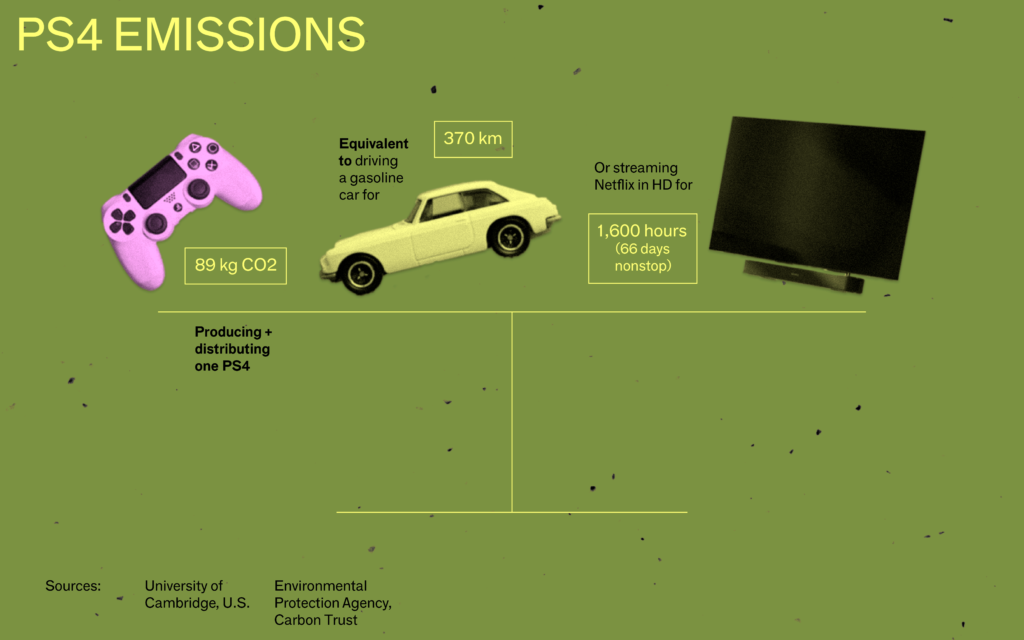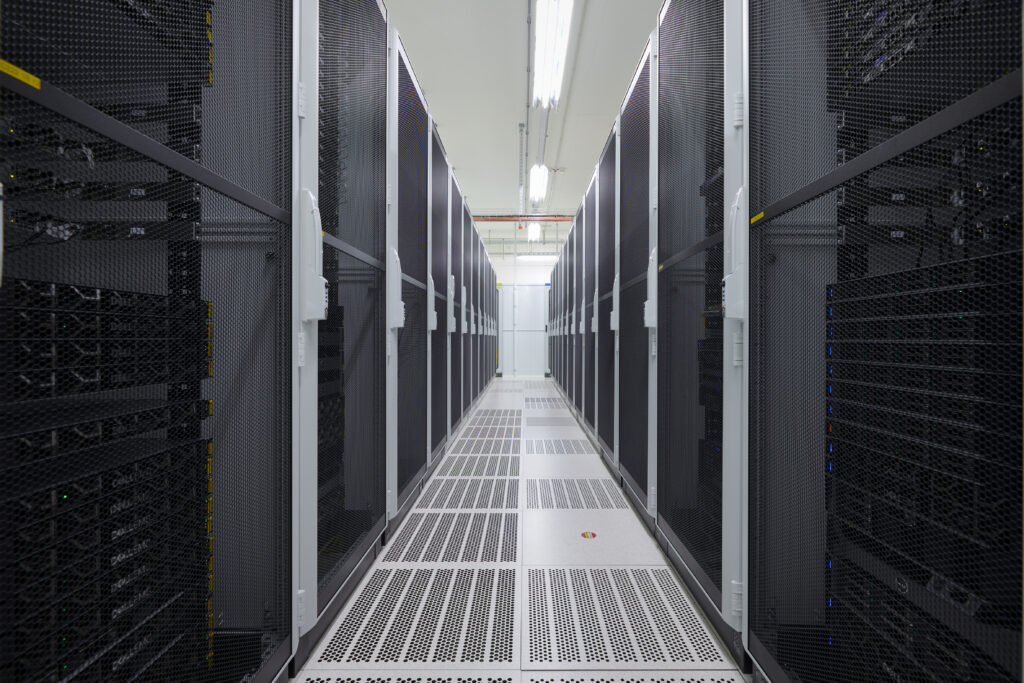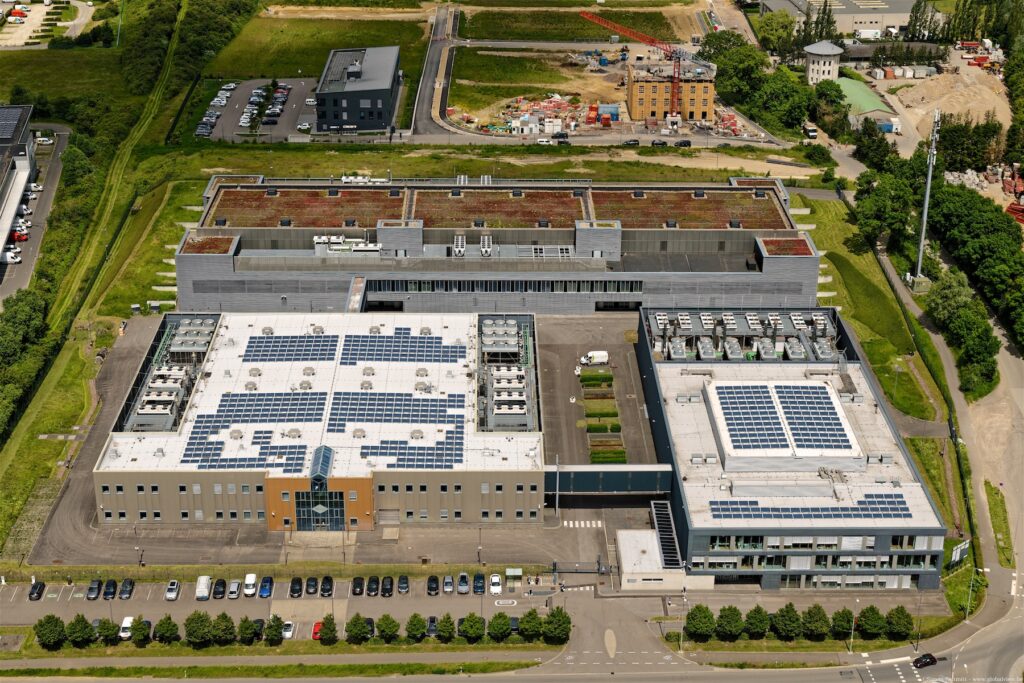Digital activities account for 40% of the CO2 emissions we can emit without triggering global warming. In the public’s perception, they’re backed-up in a cloud, which in reality isn’t white but digital and sometimes a little green.
Whether we’re tapping on a laptop, streaming a movie, or playing video games with friends, digital activity is one of the defining features of our age. Another hallmark of these modern times is climate change. Yet the two are rarely connected, with global warming more commonly linked to car exhaust or fossil fuels than to the cloud-based services we use every day.
According to a study by Green IT, digital consumption accounts for 40% of an average EU citizen’s sustainable climate footprint. The collective of sustainable technology experts uses this term to refer to the amount of CO2 people can emit while limiting global warming to 1.5°C in line with the Paris Agreement. To stave off global warming, digital activities should account for 4% of our footprint, not 40%, says Green IT.
Screen time is rising
People’s use of screens, especially for entertainment, doesn’t seem to be going anywhere. The number of gamers worldwide has surged from 2 billion in 2015 to 3.3 billion in 2024, according to trend tracker Exploding Topics. Reflecting this growth, the global gaming market has expanded from $79 billion in 2012 to an estimated $187 billion in 2025 – a 137% increase over just over a decade. Meanwhile, the video streaming market is also on a sharp upward trajectory, valued at $157 billion in 2025 and projected to more than double to $416 billion by 2030, according to research firm Grand View.
And yet, there are no fumes or noxious clouds wafting from our smartphones or TV screens. The source of their impact is obscure and comes mostly from device production cycles and the data centres supporting them. “I would present the effects through three tiers: users, network and data centres,” explains Frédéric Bordage, founder of Green IT. “Looking at the users, three quarters of the impact is linked to the devices’ production and one quarter to their electrical consumption,” he adds. Furthermore, half of the emissions generated by networks and data centres come from the sourcing of materials and manufacturing of the hardware they rely on.
The other half is linked to electrical consumption. In some cases, energy consumption can account for more. In terms of digital devices, Bordage’s verdict is that “once they have been produced and we power them, not much can be done.” In his view, to reduce their impact, gamers and people streaming videos should opt for using a single device and avoid buying multiple ones.
Culturally, gaming has shifted from crowds gathering en masse at arcades, to individuals playing alone on personal devices. A similar transformation has occurred in streaming, as viewers increasingly choose the comfort of their couch and TV over the shared experience of watching in a movie theater. These shifts in customer preferences have gone hand in hand with digital devices’ improvements that ultimately have compounding energy demands. For example, the PlayStation 2, released in 2000, was powered by just 45 watts, while the 2025 PlayStation 5 Pro is powered by 250 watts.
Direct link to environmental costs
Production is also becoming more taxing on the environment. A Green IT life cycle assessment shows that one hour of gaming emits 364g of CO2, equating to driving 2 kilometers in a combustion engine car. It also contributes to the depletion of non-living natural resources raw materials like metals and minerals.
What Does g Sb-eq Mean?
This unit measures how much of the planet’s raw materials are used up when making digital technology. It is expressed in grams of the equivalent of a rare metal called antimony. It aims to estimate the impact on non-renewable resources like metals and minerals.
Gaming consoles and high-performance PCs require more materials and energy both during manufacture and operation, whereas streaming relies on simpler devices like phones or smart TVs.
These calculations take into account gaming and streaming at home via a Wi-Fi network. Fixed connections rely on physical infrastructure, and the energy needed to operate them is low once they are installed. The negative impacts are even greater when using mobile internet, which depends on electromagnetic waves that must be generated continuously. Producing and transmitting them, especially at higher frequencies like 4G and 5G, requires more electricity.
“There are two main global challenges: avoiding short-term impacts and, above all, preserving the resources used to manufacture digital equipment,” says Bordage.
For Green IT’s founder, people’s use of gaming and streaming devices will not change in a significant way and digital emissions are not likely to become fewer than they are today. In his view, altering that trend can realistically only come from policymakers through regulations on game developers and video content distributors. “Game developers don’t sell video games but hours of games played. That is their economic model,” he says.

The power of a data centre
Regarding data centres, Bordage believes that their source of energy is the most decisive variable when it comes to how much digital emissions they lead to being emitted. And that it is closely linked to their location. Running thousands of servers 24/7 requires a lot of power and cooling. According to Bordage, building the data centre accounts for 20% of its environmental impact, and the rest is linked to the IT equipment and its energy use. When it comes to Europe, “between the best-performing data centers and the less efficient ones, the difference isn’t that big,” he says. The quality of the electricity mix is lower in Asia and Africa, for example, and facilities are linked to more water use and depletion of non-living natural resources.
Many data centres aim to optimise performance by using the most efficient equipment they can afford, which helps boost performance and also leads to reducing environmental impacts. In terms of electricity, some offer guarantees of origin to their customers who want renewable energy. “Let’s be realistic. We are probably not going to decrease energy consumption in data centres in the next few centuries. Our approach is to use renewables as much as possible,” says Paul Konsbruck, CEO of data centre LuxConnect.
A green exception
Thanks to the absence of private shareholders, state-owned Luxembourgish facilities can prioritise sustainability over profits This is one reason why the country’s data centres are powered entirely by renewable energy. As Konsbruck highlights, running a sustainable server farm doesn’t mean operating at a loss. In fact, according to Luxembourgish law, the company has to be profitable, and it is.
LuxConnect’s infrastructures are powered primarily by hydroelectric energy sourced from Norway and other Scandinavian countries. Investing in clean energy and regularly upgrading to the latest equipment are key ways that a data centre can make efforts to be more sustainable. For example, while decade old cooling systems may have had a considerable negative environmental impact, the newest generation of this technology offers a closed circuit and reuses 100% of the water in its system.
Being publicly owned has enabled LuxConnect to explore innovative ways to make its operations more sustainable. Its Bissen data centre is part of an energy generation site called Kiowatt. Kiowatt features a cogeneration plant wherein another company burns wood waste to produce electrical energy while the residual energy is used to cool the data centre and power an urban heating network.


The customer is always right
Sustainable practices like those implemented by LuxConnect are still the exception, rather than the norm. According to Konsbruck, whether or not a data centre implements eco-friendly methods depends on its customers. Luxembourg is a financial hub and many of LuxConnect’s clients are institutions that promote climate consciousness. The rise of the Environmental, Social, and Governance (ESG) framework and green investment has also led to the popularisation of sustainable certifications– even if some organisations are only in it for the label.
“If your data centre caters to crypto miners, gaming, or gambling, it’s probably less important for those customers than it would be for others,” says Konsbruck.
However, determining how environmentally responsible a data centre actually is, is challenging.
“The notion of the cloud being something quite ephemeral was supposed to replace the idea of the analog and the idea of material things. But as a marketing term, it has made people unaware that the cloud is one of the biggest infrastructures we have.”
Cloudy with a chance of CO2
In Europe, many countries use certification systems like Guarantees of Origin, allowing companies to verify and track their electricity’s source. This is trickier in the USA where a fragmented grid mixes power from different sources. In Canada, tracking energy sources varies by province, making transparency uneven across the country. Across South America, energy tracking differs per country. Rapid industrial growth and diverse energy mixes in Asia create challenges for clear tracing, while Africa and the Middle East are characterised by a reliance on traditional energy sources.

“I have visited about 10 data centres and, maybe it’s different in Luxembourg, but in the US and Canada, you don’t know where the energy comes from,” says Mél Hogan, associate professor at Queen’s University in Canada. As part of her research, she has explored data centres in Scandinavia and North America.
These networks of remote servers are often referred to as “the cloud”. Professor Hogan has explored the public perception of the term, noting that: “The notion of the cloud being something quite ephemeral was supposed to replace the idea of the analog and the idea of material things. But as a marketing term, it has made people unaware that the cloud is one of the biggest infrastructures we have. It has a location, it is subject to floods, fires, tornadoes and it is very highly guarded,” she says.
For Hogan, the most important question is: who owns these high-tech infrastructures? For example, while most people think of Amazon as a retailer, streaming platform or tech company, in fact Amazon Web Services (AWS) are used by game developers like Ubisoft, Epic Games or Riot Games. AWS offers cloud computing, allowing companies to rent servers and storage over the internet instead of building their own. It is also used by streaming platforms like Netflix and Hulu. The American company claims its servers are powered by 85% renewable energy, but critics like Greenpeace, argue the company’s rapid growth is leading to more investment in fossil fuels. There has also been broader criticism over a lack of transparency. Apple, Google, Meta and Microsoft also run large data centres, accounting for a significant portion of the market and therefore emissions.
“At one point, we saw those tech companies as the sign of progress and a liberal utopia. They can’t both be the promise of the future and not be responsible for the future that we’ve created in the past 10 years,” says Hogan.
Holding those major companies accountable is key for Hogan who argues that “it doesn’t matter so much if you stream in high definition but it might matter at a policy level or a collective unionized level if we ask: What are the costs? What is the environmental impact of those technologies? How do we ensure that they are sustainable?”
